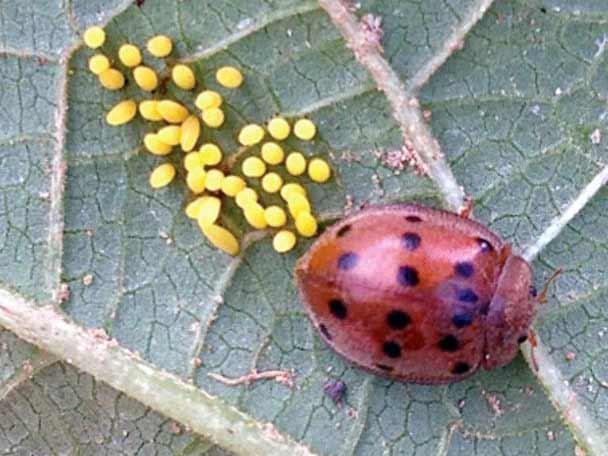Open-access article on Mexican bean beetles offers control tips

This is a Mexican bean beetle (Epilachna varivestis) adult with eggs. Credit: Entomological Society of America
“If you look through the literature on this pest, there are probably only 10 or so articles in the past 20 years, and nothing in terms of a profile-type article since the 1930s,” said Nottingham, a PhD student and graduate research assistant in the lab of Professor Tom Kuhar at Virginia Tech. “It was time to bring more attention to this beetle that is so significant in our growers' lives.”
A type of lady beetle originally known from high elevations of western Mexico and Central America, the Mexican bean beetle showed up in the western United States in the late 1800s in connection with the spreading cultivation of beans. The beetle favors wax beans and green snap beans in the genus Phaseolus. It will, however, eat all types of legumes, including alfalfa, and as settlers began transporting that forage plant to the East Coast as animal feed, they brought the beetles along.
After reviewing the available literature on the beetles, the researchers may have discovered a behavioral trait that can be used against them.
“If you look back in the literature, you'll see that if you shine a light on different sides of a bean plant, the beetles always abscond to the other side. That also explains why you find every life stage — eggs, larvae, pupae, and even the adults — almost always on the shaded side of the leaves,” Nottingham said.
After some thought about how they could manipulate light conditions, they decided to try metalized plastic mulch, which looks much like a sheet of aluminum foil with black backing. When placed on the soil around the plants, the mulch reflects light onto the bottoms of bean-plant leaves.
They contrasted small outdoor bean plots using the reflective mulch, black plastic sheeting, or plain soil, and observed beetle numbers, plant damage, and plant growth. Farm-scale research on the effect of reflective mulch remains to be conducted, but it looks good so far.
“We found significantly less of every life stage on plants in our plots with reflective mulch vs. black plastic and bare ground,” Nottingham said. “And the plants grew way better and had far less plant injury.”
Other options include mechanical removal, row covers, and the use of parasitoids.
###
The full article, “Natural History, Ecology, and Management of the Mexican Bean Beetle (Coleoptera: Coccinellidae) in the United States,” is available for free at http://dx.
The Journal of Integrated Pest Management is published by the Entomological Society of America, the largest organization in the world serving the professional and scientific needs of entomologists and people in related disciplines. Founded in 1889, ESA today has nearly 7,000 members affiliated with educational institutions, health agencies, private industry, and government. Members are researchers, teachers, extension service personnel, administrators, marketing representatives, research technicians, consultants, students, and hobbyists. For more information, visit http://www.
Media Contact
All latest news from the category: Agricultural and Forestry Science
Newest articles

After 25 years, researchers uncover genetic cause of rare neurological disease
Some families call it a trial of faith. Others just call it a curse. The progressive neurological disease known as spinocerebellar ataxia 4 (SCA4) is a rare condition, but its…

Lower dose of mpox vaccine is safe
… and generates six-week antibody response equivalent to standard regimen. Study highlights need for defined markers of mpox immunity to inform public health use. A dose-sparing intradermal mpox vaccination regimen…

Efficient, sustainable and cost-effective hybrid energy storage system for modern power grids
EU project HyFlow: Over three years of research, the consortium of the EU project HyFlow has successfully developed a highly efficient, sustainable, and cost-effective hybrid energy storage system (HESS) that…





















